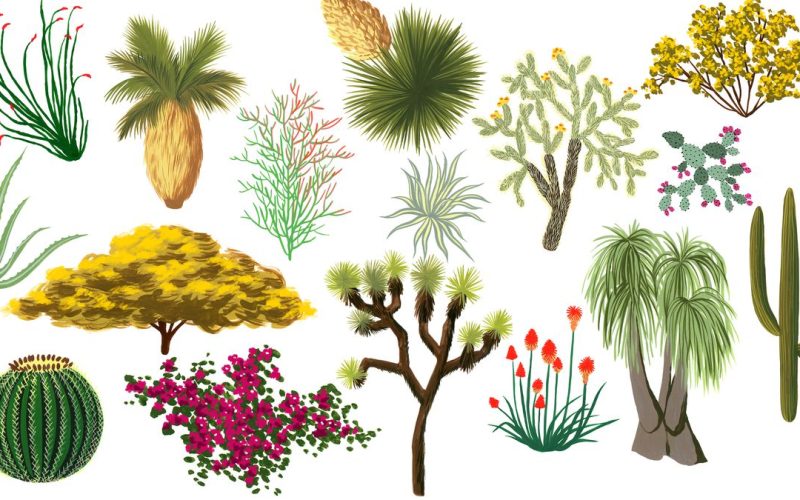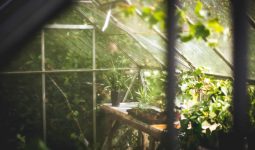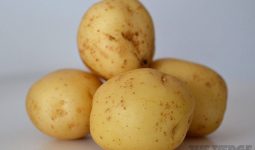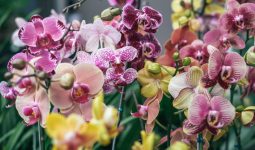The world’s deserts, with their vast expanses of arid landscapes and seemingly harsh conditions, have long captured the imagination of explorers, scientists, and nature enthusiasts alike.
While deserts may appear barren and lifeless at first glance, a closer look reveals a remarkable tapestry of plant life that has evolved ingenious adaptations to thrive in these extreme environments.
We embark on a journey to uncover the secrets of desert flora and explore the remarkable diversity of plants that call these harsh regions home.
Deserts are defined by their arid climate, characterized by limited rainfall and high temperatures.
These conditions present formidable challenges for any life, yet deserts are far from lifeless.
There are different types of plants in the desert, and these plants have developed various survival strategies that allow them to exist and flourish in these seemingly inhospitable terrains.
Throughout this article, we will explore the world of desert plants, from the iconic cacti and succulents with their water-storing adaptations to the delicate wildflowers that grace the desert floor during rare bursts of color.
We will meet tenacious shrubs, towering trees, and the fleeting annuals and perennials that thrive in adversity. We will discuss the different types of edible plants in the desert.
Join us as we embark on an awe-inspiring expedition into the heart of desert landscapes, where life has not only endured but also evolved in extraordinary ways.
By the end of this guide, you will have a newfound appreciation for the resilient and diverse world of the types of plants in the desert, understanding why they are not just survivors but also essential contributors to the intricate balance of our planet’s ecosystems.
Different Types of Plants in the Desert
For enjoyment and enlightenment, the different types of plants in the desert are subdivided into six groups in this article, which are:
- Desert Succulents
- Desert Wildflowers
- Desert Shrubs
- Trees of the Desert
- Annuals and Perennials
- Edible Desert Plants
Let’s explore them. Shall we?
1. Succulents
The desert is a realm where the sun reigns supreme, water is a precious commodity, and survival hinges on the ability to endure harsh conditions.
In this unforgiving environment, one group of plants stands out as the ultimate masters of adaptation: succulents.
Let’s discuss the different examples of desert succulents.
Examples of Desert Succulents
When we think of desert succulents, we often imagine towering saguaro cacti or the striking symmetry of an agave plant.
These iconic species have become emblematic of desert landscapes and showcase the diverse forms and adaptations found within the succulent family. They are among the types of plants in the desert.
1. Saguaro Cactus
The saguaro succulents are the most recognizable type of plant in the desert, standing as a sentinel in the Sonoran Desert of the southwestern United States and northern Mexico.
Its towering, ribbed stem and upraised arms can store thousands of liters of water, supporting a rich ecosystem of birds and insects.
2. Agave
Also, one type of plant in the desert is the Agave. Agaves come in various shapes and sizes, from the diminutive agave parviflora to the massive agave americana.
They are known for their striking rosette of spiky leaves; indigenous cultures have utilized agaves for centuries for food, fiber, and fermented beverages like tequila.
3. Barrel Cactus
Barrel cacti are known for their distinctive, barrel-shaped appearance. They often have prominent ribs and large, colorful flowers at their tops.
These succulents are excellent at storing water in their thick stems, enabling them to endure extended droughts in various desert regions.
4. Aloe
Aloe plants are one of the different types of plants in the desert. They are renowned not only for their drought-resistant qualities but also for their medicinal properties.
They have thick, fleshy leaves filled with gel-like sap and have been used for centuries to treat burns and skin ailments. Aloe vera is a well-known species in this genus.
5. Prickly Pear Cactus
Prickly pears are easily recognizable by their flat, pad-like stems covered in glochids and tiny hair-like spines that can be pretty irritating.
They produce vibrant, paddle-shaped pads and colorful, edible fruits known as prickly pear or nopales, which are used in culinary dishes in various cultures.
6. Yucca
Yuccas are characterized by their sword-like leaves and striking, tall spikes of white or cream-coloured flowers.
These plants often form a central rosette of leaves from which the flower stalk emerges. Some yucca species, like the Joshua tree, have become iconic symbols of the desert.
7. Sotol
Sotols are native to arid regions of the Americas and are notable for their long, slender leaves that resemble coarse grasses or yuccas. They typically produce tall flower spikes and are known for their resilience in desert environments.
8. Echeveria
Echeveria falls under the category of types of plants in the desert. Echeveria are a diverse group of small, rosette-forming succulents known for their stunning and often colorful foliage. They are popular in succulent gardens and are cultivated for their aesthetic appeal.
9. Senita Cactus
The senita cactus is a slender, columnar cactus with a unique appearance. It features vertical ribs and long, hair-like spines.
The senita cactus in the Sonoran Desert provides habitat and food for various desert wildlife.
10. Peyote
Peyote is a small, spineless cactus native to the Chihuahuan Desert. Its rich cultural history has been used in indigenous rituals for centuries. However, it is also threatened by overharvesting and habitat destruction.
2. Desert Wildflowers
The desert harbors a captivating secret that bursts forth in ephemeral brilliance even though it may be synonymous with arid landscapes and seemingly desolate expanses. This fascinating secret is brief but beautiful- the desert wildflowers.
Desert wildflowers are the embodiment of patience and adaptability. They lie dormant, often for years, awaiting the perfect conditions to germinate, grow, and flourish.
When the rare convergence of factors occurs- sufficient rainfall, temperature, and sunlight- these hardy seeds awaken, transforming the desert into a canvas of vibrant colors.
Examples of Desert Wildflower Species
1. Desert Marigold
The desert marigold, with its bright yellow petals, adds cheerful color to arid landscapes. It is often among the first wildflowers to appear after rain in southwestern deserts.
2. Brittlebush
The silvery-green leaves and yellow, daisy-like flowers of the brittlebush are iconic features of the Sonoran and Mojave Deserts. This plant also exudes a pleasant, resinous fragrance, making it unique.
3. Ocotillo
Ocotillo is a unique desert plant that appears as a cluster of tall, spiny stems. Following rainfall, it produces brilliant red tubular flowers along its branches, attracting pollinators like hummingbirds.
4. Desert Lupine
Lupines are known for their distinctive palmate leaves and towering spikes of pea-like flowers. The desert lupine is striking when it blankets the desert floor with blue or purple blossoms.
5. Desert Paintbrush
Desert paintbrushes are known for their vibrant, tubular flowers ranging from red to orange. These wildflowers are often associated with arid regions of the American Southwest.
3. Desert Shrubs
Amidst the seemingly barren expanse of the desert, a diverse array of shrubs stands as stalwart guardians of the ground.
These unassuming plants, often overlooked in favor of more striking cacti and succulents, play vital roles in desert ecosystems, offering stability, shade, and sustenance in an otherwise challenging landscape.
Desert shrubs, sometimes called chaparral or xerophytic shrubs, are hardy plants adapted to arid and semi-arid environments.
They are characterized by their woody stems, small to medium size, and a range of adaptations that allow them to thrive in scarce water.
Examples of Desert Shrubs
1. Creosote Bush (Larrea tridentata)
The creosote bush is an example of a plant in the desert. It is an iconic desert shrub, often forming extensive clonal colonies that can be thousands of years old.
Its small, dark green leaves and tiny, yellow flowers recognize it. Creosote bushes are well-adapted to desert environments and are known for their distinctive resinous aroma.
2. Mojave Desert Sagebrush
Sagebrush is a common sight in the high deserts of North America, including the Mojave Desert. Its silvery-grey foliage and aromatic scent make it easily recognizable. It provides food and shelter for various wildlife species.
3. Blackbrush
Blackbrush is a low-growing desert shrub with tiny, evergreen leaves and fragrant yellow flowers. It plays a significant role in stabilizing soil and provides food for desert animals.
4. White Bursage
White bursage is another desert shrub that forms dense stands in arid regions. It is known for its silvery-white appearance and is an essential food source for desert herbivores.
5. White Desert Thorn
White desert thorns are low, spreading shrubs with tiny leaves and thorny branches. They produce small, trumpet-shaped white or pale pink flowers and are essential food sources for desert wildlife, including birds and insects.
6. Big Sagebrush
Big sagebrush, a subspecies of sagebrush, is found in the western United States and is known for its aromatic, silver-gray leaves. It provides habitat and food for various animals, including sage grouse and rabbits.
7. Desert Holly
Another example of the different types of plants in the desert is the desert holly. The desert holly is a compact, silvery-gray shrub with small, scale-like leaves. It is well-adapted to saline desert soils and an essential food source for desert herbivores.
8. Four-Wing Saltbush
Four-wing saltbush is a highly adaptable desert shrub with leaves that resemble scales. It is named for its four-winged seeds and is vital for stabilizing soil in arid regions.
9. Desert Ironwood
Desert ironwood is a slow-growing, long-lived shrub or small tree native to the Sonoran Desert. It is known for its harsh and heavy wood and produces clusters of purple flowers that attract pollinators.
10. Smoke Tree
Smoke trees are spiny shrubs with fern-like leaves and blush-green stems. They produce vivid purple flowers after rain, strikingly contrasting their foliage.
Desert shrubs are heroes of arid landscapes, providing stability, sustenance, and shelter in environments where survival is a daily battle.
Their presence is a testament to the remarkable adaptability of life and the intricate web of connections that sustain desert ecosystems.
Let’s turn our attention to the giants of the desert- the trees that tower above the arid landscapes and contribute significantly to the ecosystem’s diversity and complexity.
4. Trees of the Desert- Tall and Tenacious
In the vast expanse of the desert, where wild conditions challenge the very essence of life, there stand tall and tenacious sentinels- the desert trees.
They are a symbol of endurance and adaptability. They are often characterized by their towering height, deep root systems, and remarkable features that enable them to thrive in arid regions. These trees stand as green oases, offering wildlife and refuge for weary travelers.
Examples of Desert Trees
1. Joshua Tree
The Joshua tree is an iconic desert tree known for its bizarrely contorted branches and sharp, spiky leaves. It is primarily found in the Mojave Desert and is an important food source for desert animals like the yucca moth.
2. Palo Verde
Palo Verdes are distinctive desert trees with green bark and tiny leaves. They are well-adapted to water-stressed environments and are capable of photosynthesis even in their branches, an adaptation that conserves water.
3. Ironwood
Ironwood trees are native to the Sonoran Desert and are known for their dense hardwood. They produce clusters of purple flowers and provide shade and food for desert wildlife.
4. Mesquite
Mesquite trees are common in many desert regions and are recognizable by their feathery, compound leaves. They produce sweet and nutritious bean pods, a food source for indigenous people for centuries.
5. Palm Trees
Palm trees such as the California fan palm and the date palm are found in desert oases. These trees thrive in areas with access to underground water sources and provide shade and edible fruit.
6. Desert Willow
The desert willow is a small tree with long, narrow leaves and trumpet-shaped flowers. It is well adapted to arid environments and is known for its striking, fragrant blossoms.
7. Blue Palo Verde
Blue palo verde is a species of palo verde tree known for its green bark and bright yellow flowers. It is a common sight in the Sonoran Desert and is a valuable source of nectar for pollinators.
8. Smoke Tree
Smoke trees are adaptable desert trees with feathery leaves and a bushy appearance. They produce clusters of purple flowers after rainfall.
9. Texas Ebony
Texas ebony is a dense, dark-colored tree native to arid regions of Texas and Mexico. It is valued for its intricate wood and produces small, fragrant flowers.
10. Date Palm
Date palms are cultivated in desert oases for their sweet and nutritious fruit. Their towering trunk and pinnate leaves characterize them.
These majestic trees, lofty canopies, and clusters of golden-brown fruit have been a source of sustenance and cultural significance for millennia.
11. Acacia Trees
Various species of acacia trees are found in desert regions around the world. They are known for their distinctive compound leaves and provide food and shelter for wildlife.
12. Desert Hackberry
Desert hackberry is a small to medium-sized tree with serrated leaves and sweet fruit. It is a valuable food source for birds and mammals in the desert.
Desert trees stand as resilient symbols of life in the harshest environments and play vital roles in desert ecosystems.
Let’s explore the short-lived but captivating annual and perennial plants that contribute their unique beauty and adaptations to the desert’s fragile tapestry.
5. Annuals and Perennials- Short-lived Wonders
Annual and perennial plants in deserts are characterized by their relatively short lifecycles, contrasting with the longevity of desert trees and shrubs.
They have developed strategies to capitalize on limited moisture and thrive during the brief windows of opportunity provided by seasonal rains.
Desert annuals are another type of plants in the desert that complete their entire life cycle within a single growing season, often from seed to flowering and seed production in a matter of weeks or months.
Desert perennials have a longer lifespan, with plants persisting for multiple growing seasons. They often rely on underground storage structures, such as bulbs or tubers, to survive prolonged droughts.
Examples of Annuals and Perennials
Annual Desert Plants
1. Desert Sunflower
This annual wildflower is known for its bright yellow flowers that blanket desert landscapes after rainfall.
2. Desert Poppies
Desert poppies are another type of plant in the desert. They are famous for their vibrant orange or yellow petals, creating breathtaking displays when they bloom.
3. Desert Marigold
This annual plant produces cheerful yellow flowers and is common in various desert regions. They also quite famous in some regions.
4. Sand Verbena
Sand verbena are low-growing annuals with clusters of fragrant flowers in pink, purple, or white shades.
5. Desert Bluebell
Desert bluebells are known for their bell-shaped, blue-purple flowers that carpet the desert floor after rains.
6. Desert Paintbrush
Desert paintbrushes are annual wildflowers with vibrant, tubular flowers in red, orange, or pink shades.
7. Sand Lily
Sand lilies are annuals that produce delicate white flowers with a subtle fragrance, often found in sandy desert soils.
8. Desert Chicory
These annual plants produce bright pink to lavender flowers with distinctive fringed petals. They are known for their beauty among other attributes.
Perennial Desert Plants
1. Desert Mariposa Lily
This perennial plant produces striking, tulip-like flowers with white or lavender petals and is native to arid regions.
2. Desert Agave
Desert agaves are another type of plant in the desert. They are perennial succulents known for their striking rosette of sharp, pointed leaves. They can live for several decades and bloom once in their lifetime.
3. Desert Lily
The desert lily is a perennial bulb plant with tall spikes of white, fragrant flowers. It is adapted to desert washes and sandy areas.
4. Brittlebush
Brittlebush can be both annual and perennial. It is more perennial than annual, though. It is often a perennial shrub with gray-green leaves and yellow daisy-like flowers.
5. Desert Evening Primrose
Desert evening primroses are perennials known for their large, white, or pink, fragrant flowers that open in the evening.
6. Desert Verbena
Desert verbena is a perennial ground cover with clusters of small, colorful flowers in purple, pink, or white shades.
7. Globe Amaranth
These perennials are known for their spherical clusters of tiny, bright-colored flowers and are often found in desert gardens.
The annual and perennial plants in the desert are living testaments to the tenacity and adaptability of life in challenging environments.
Their ability to quickly respond to changing conditions, burst into vibrant blooms, and provide sustenance to desert inhabitants underscores their significance in the intricate desert ecosystem.
The next subcategory under the types of plants in the desert in this article is edible plants. Let’s discuss the various examples of edible desert plants.
6. Edible Desert Plants- Nature’s Pantry in Arid Lands
Edible desert plants have been vital sources of food, water, and traditional medicines for indigenous people of arid regions. Many of these plants have unique adaptations that make them suitable for consumption, even in the harshest conditions.
Examples of Edible Desert Plants
1. Creosote Bush
While not a primary food source, the creosote bush leaves can be used to make herbal teas and infusions with potential medicinal properties.
2. Agave
Agave plants have been cultivated for centuries by indigenous cultures for their edible leaves, and the sweet sap (aguamiel) used to make traditional beverages like pulque and mezcal.
3. Jojoba
Jojoba plants produce oil-rich seeds that can be processed into jojoba oil. This oil has a variety of uses, including as a cosmetic ingredient and a carrier oil for essential oils.
4. Cholla Cactus
Cholla cacti produce fruit known as “cholla buds,” which are edible when harvested at the right stage. These buds are often used in traditional Native American cuisines.
5. Amaranth
Various species of amaranth, such as red-root amaranth, are edible and provide nutrient-rich greens and seeds. Amaranth seeds can be ground into flour or popped like popcorn.
6. Desert Holly
Desert holly produces tiny, edible seeds, historically an essential food source for indigenous people in the Southwest.
7. Indian Rice grass
Indian rice grass produces tiny, rice-like seeds that have been used as a food source by indigenous communities. It is often ground into flour for making bread and porridge.
8. Desert Prickly pear
This prickly pear cactus species is valued for its pads and fruits. It is used in various traditional dishes and can be eaten fresh or dried for later use.
9. Pomegranates
Among the harsh landscapes of desert regions, the pomegranate is a dazzling gem in appearance and cultural significance.
Pomegranate trees possess a tenacity that allows them to flourish in arid conditions. Pomegranates are not only alluring but also exceptionally nutritious. Their seeds, known as arils, are packed with vitamins, antioxidants, and dietary fiber.
10. Desert Figs
Certain species of fig trees have adapted to desert conditions. Desert figs bear sweet, succulent fruit and play a crucial role in desert ecosystems by providing food for various wildlife species. They are remarkable in their ability to adapt to the harsh conditions of desert environments.
11. Barbary Figs
Barbary figs are also called desert barbary. They are native to arid regions; their tart berries are used in traditional medicine and culinary applications, adding a distinctive flavor to dishes.
Barbary figs can be used to make jams, preserves, and marmalades. Their high pectin content makes them suitable for thickening and setting into delicious spreads.
12. Acacia Gum
The sap of the Acacia Senegal tree is used to produce gum acacia, a valuable substance used in the food and beverage industry for its thickening and stabilizing properties.
Acacia gum has a wide range of uses in various industries, such as the food and beverage industry, pharmaceuticals, cosmetics and personal care products, print and art applications, textile industry, flavor and fragrance industry, and even photography.
13. Desert Lime
Another type of plant in the desert is the desert lime, native to arid regions of Australia. They are small, round citrus fruits with a tart flavor. They are used in cooking, as a condiment, or for making jams and beverages.
Desert lime can be used in baking, flavoring, and making jams and preserves. It can also be used for cocktails and mixers, cordials and syrups, sauces, chutneys, spices, and seasonings.
14. Sahara Olive
An ancient subspecies of olive trees survives in the hyper-arid Sahara Desert. These olives are smaller and more bitter than their Mediterranean counterparts but have cultural and culinary significance in the region.
While it is less widely known or cultivated than its Mediterranean counterparts, it does have several traditional uses and potential applications in arid areas.
15. Desert Apricot
Among the types of plants in the desert is the desert apricot. Native to North American deserts, the desert apricot produces small, sweet, and tangy fruits.
They are enjoyed fresh or used in jams and preserves. These fruits can be eaten fresh when ripe, although they are less widely cultivated or consumed than typical apricots.
16. Desert Almond
Desert almond trees are found in arid parts of Africa and produce small, almond-like fruits. These fruits are used for their oil and as a food source during times of scarcity. The seeds of the desert almond are edible, often roasted, and consumed as a snack.
Desert almond seeds are also a source of oil. This oil is used in cooking and can also be used in cosmetic products like skincare oils and hair conditioners.
17. Desert Strawberry
Desert strawberry varieties, such as the wild strawberry Fragaria vesca, can be found in arid regions. These smaller strawberries have a unique flavor and are sometimes used in local culinary dishes.
Desert strawberry plants are another type of desert plant that produces small, sweet, flavorful, edible berries. These berries can be consumed fresh when ripe and have a pleasant, sweet-tart taste.
18. Desert Figwort
The root of the desert figwort plant can be consumed and is used in traditional medicine by some indigenous communities. Desert figwort has a history of use in traditional herbal medicine by indigenous people and herbalists.
It is believed to have medicinal properties and has been used to treat various ailments, including respiratory, skin, and digestive problems.
19. Desert Olive
Another species of olive tree produces fruits that grow in the desert. This species is adapted to arid climates and produces small, olive-like fruits used in various culinary and medicinal applications.
Desert olives have small, edible fruits. They are harvested and can be consumed when ripe, although they are typically smaller and more bitter than olives from the standard olive tree.
20. Desert Melon
Desert melon is also known as bitter cucumber or colocynth. This small, bitter fruit grows in desert regions of Africa and Asia.
While not typically consumed due to its extreme bitterness, it has been used for medicinal purposes.
Desert melon is believed to have medicinal properties. It has been used to treat various ailments, including digestive disorders and skin conditions, and as a natural remedy for pain and inflammation.
21. Desert Quandong
The desert quandong plant can be found in the arid regions of Australia and produces a small, red fruit known for its tartness.
It is used in jams, desserts, and sauces. The fruit of the desert quandong is the most well-known part of the plant. These fruits are small, round, and brightly colored, typically red or orange when ripe.
Desert quandong fruits have a tart and tangy flavor and can be eaten fresh. They are often used to make sauces, chutneys, and relishes, adding a unique tartness to both sweet and savory dishes.
22. Desert Peach
Native to North America’s southwestern deserts, desert peaches produce small, sweet fruits enjoyed by wildlife and used by indigenous people for their edible flesh.
Desert peach fruits can be used in various culinary applications, including baking, desserts, and beverages. They are valued for their unique flavor.
They also serve as an essential food source for wildlife in arid and semi-arid regions. Birds, rodents, and other animals feed on the fruits, contributing to local biodiversity.
Edible desert plants are bounties that have sustained human and animal populations for centuries, providing nourishment and sustenance where few other options exist.
Conclusion
The world’s deserts, often seen as desolate and barren landscapes, are, in reality, teeming with life, thanks to the remarkable adaptability of desert plants.
From towering saguaros to diminutive wildflowers, these plants have evolved ingenious strategies to survive and thrive in some of the harshest environments on Earth.
In this exploration of desert flora, we’ve encountered a vast array of plant life, each with its unique adaptations and contributions to desert ecosystems.
The towering saguaros and Joshua trees, the hardy succulents, and the tenacious desert shrubs provide stability and sustenance in arid landscapes. Their resilience in the face of extreme temperatures and scarce water resources is a testament to nature’s ingenuity.
We have marveled at the short-lived but captivating annual and perennial plants that burst into temporary displays of color after rare desert rains. With their swift life cycles and resourceful adaptations, these plants offer sustenance and beauty in an otherwise harsh environment.
Then there are the edible desert plants in nature’s pantry in arid lands. Prickly pear cacti, date palms, and mesquite trees have nourished wildlife and humans for generations, connecting people to the ground and their cultural heritage.
These plants offer a lesson in sustainable living, reminding us of the importance of conservation and responsible harvesting.
As we conclude this long journey through the world of desert plants, we are left with a profound appreciation for their resilience and diversity of life in these challenging environments.
The desert, far from being lifeless as it was tagged, is a testament to nature’s ability to adapt, survive, and thrive under the most adverse conditions.
It reminds us that life finds a way in the harshest circumstances and that beauty blooms in the most unexpected places.








